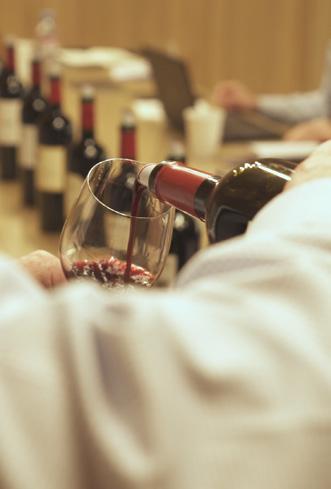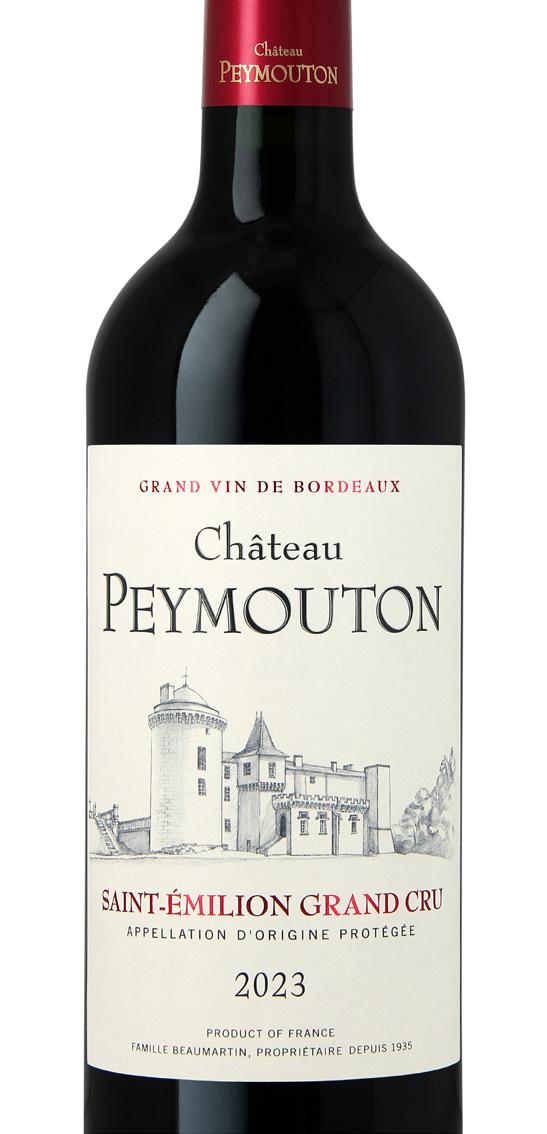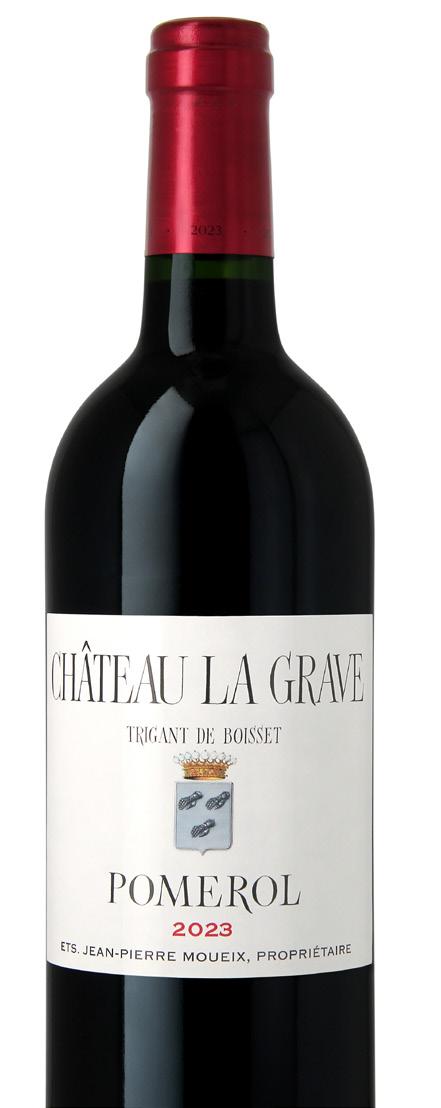








“The heat at the end of August saved the vintage”
ÉDOUARD MOUEIX, APRIL 2024
Our annual Moueix tasting tends to take place on the third Saturday in April: a period where, if you’re lucky, you see south-west France’s spring in all its glory. This year, in a fitting nod to the 2023 vintage, we were lucky.
Basked in sunshine therefore, we made our way, not to Moueix HQ on Libourne’s Quai du Priourat as usual, but to Château Bélair-Monange’s glamorous new winery. This gleaming addition to the Saint-Émilion landscape was designed by architects Herzog & de Meuron, also responsible for Bordeaux’s new football stadium.
A landscape wall of glass (pictured on the previous pages) separates the tasting room from the sunken barrel cellar, which is modelled on the Moueix family’s Dominus in Napa. Conical chandeliers hang from the ceiling, bathing the maturing vintage in soft white light. Having tasted the range in our habitual sepulchral silence, we ascended to the building’s vast top floor to taste Bélair-Monange itself, whilst gazing at the vines from whence it came.
You can see that one could be swayed amid such glitz. Fortunately, we are scrupulous professional tasters – and we also had a chance to revisit the wines earlier this month in London. At that second tasting they were, if anything, even better.
2023 is a distinct success at the Moueix properties. It is a vintage borne of fickle weather, which alternated between hot and cold, dry and wet. As Édouard Moueix’s quote above makes clear, it was plucked from indifference by a glorious late summer burst of warmth and sunshine. Here is how it played out…
After a generally mild and dry winter, punctuated by a few cold spells, the first leaves appeared on the vines on 29th March, falling in line with the past ten years. A homogenous budbreak augured well.
Mildew pressure in April and May was caused by stormy weather combined with above-average temperatures. However, thanks to what Édouard called “the exemplary rapid response of our vineyard teams”, these attacks were adeptly countered, saving the entire crop.
Flowering started early, on 23rd May, with large quantities of pollen heralding a big crop. When we spoke to Édouard at Bélair-Monange last month, he explained how the “perfect flowering” conditions resulted in an average of 300 berries on each bunch – a generous crop indeed.
The summer was unpredictable, with some intense storms in June and temperatures 3°C above the seasonal average. July was relatively cool, with light but frequent rain. The vines maintained their lead and véraison (colour change) got underway, with the first coloured berries appearing on 17th July.
Green harvesting significantly reduced yields, enabling ripening and safeguarding the uniformity of the crop. As Édouard explained, “the overcast month of July made us worry whether the vines could bring to maturity” so many grapes.
August was something of a rollercoaster. A cool start gave way to an “intense” heatwave from the 16th to the 24th, followed by a sudden drop in temperature. Total hours of sunshine were “below expectations”, in contrast with the plentiful sun of recent vintages. Nonetheless, this period was described by Édouard as “a beautiful two weeks at the end of August and a beautiful two weeks at the beginning of September.”
The early September heatwave gave way on the 11th to light rainfall, which encouraged the final push of ripening. The harvest took place amid summer conditions, in an unhurried window between 7th and 29th September. As Édouard evoked it, “almost three weeks of carefully observing each parcel, tasting the berries daily and occasionally interrupting picking to ensure optimum quality.” In the cellar, there was minimal intervention, with a gently controlled maceration and extraction, interspersed with light pump-overs to preserve the quality and elegance of the tannins.
And so the 2023 wines? They are quite something. Saint-Émilion Grand Cru Château Peymouton is fast becoming a C&B favourite and is not to be missed. Clos Saint-Martin, the smallest Grand Cru Classé in SaintÉmilion, is radiant and intense. In Pomerol, La Grave and Bourgneuf have both over-performed, the former racy and refined, the latter showing flashes of its close neighbour Trotanoy. Of the hallowed names, La FleurPétrus shines particularly brightly in 2023 – that Moueix elegance incarnate.
GUY SEDDON Head of Fine Wine BuyingMay 2024




Château Peymouton
Saint-Émilion Grand Cru

We originally offered this in the 2021 vintage as a substitute for Barrail du Blanc and it was so good again in 2022 that we just had to buy it. Well, there is no Barrail du Blanc in 2023 either so we are rather glad it’s still here. Part of the Château Laroque estate and immediate neighbour to Peter Sisseck’s brilliant Château Rocheyron, Peymouton sits on clay-limestone soils. In 2023, it offers dark berry fruit with a fresh mint lift, framed by clipped, refined tannins. The finish is nicely tapered and gently herbaceous.
Corney & Barrow Score 17+
Recommended drinking from 2027 - 2032
£144/CASE OF 12 BOTTLES, IN BOND UK
£72/CASE OF 6 BOTTLES, IN BOND UK
£154/CASE OF 6 MAGNUMS, IN BOND UK
£82/CASE OF 1 DOUBLE MAGNUM, IN BOND UK
Vineyard size:
31 hectares
Soil types:
Thin layer of rich clay over limestone; deep red clay
2023 vintage blend:
89% Merlot, 10% Cabernet Sauvignon, 1% Cabernet Franc
Château Plince Pomerol
An old favourite of ours and rather grandly sited between Châteaux Nenin and La Pointe, Château Plince is an 8.66 hectare vineyard. A lush red-berried, cedary nose, with herby spices and coffee beans. The palate is very pure, with an admirable poise between fruit and oak, then a nice crunch to the finish. Picked 13th to 20th September. This will age for 12-18 months in French oak barrels (a third new, a third one year old and a third two years old).
Corney & Barrow Score 17
Recommended drinking from 2027 - 2033
£240/CASE OF 12 BOTTLES, IN BOND UK
£120/CASE OF 6 BOTTLES, IN BOND UK
£250/CASE OF 6 MAGNUMS, IN BOND UK
Vineyard size:
8.5 hectares
Soil types:
Dark soil on iron pan
2023 vintage blend:
85% Merlot, 15% Cabernet Franc
Pomerol
100% Merlot and perfectly married to its heavy clay soils, this nine-hectare vineyard was acquired by the Moueix family in 1953. It has long been a C&B favourite. The 2023 is a wine of pure raspberry and rose aromas, with a bluehued aromatic prettiness to the medium-bodied palate, which is framed by assertive tannins and lifted by a fresh line of acidity. Picked 7th to 19th September. This will age for 16-18 months in French oak barrels (30% new).
Corney & Barrow Score 17
Recommended drinking from 2027 - 2033+
£270/CASE OF 12 BOTTLES, IN BOND UK
£280/CASE OF 6 MAGNUMS, IN BOND UK
Vineyard size:
9 hectares
Soil types:
Gravel on clay and old, deep. blue clay
2023 vintage blend:
100% Merlot
Pomerol
This curious name comes from the château’s location, on the northern edge of the plateau of Pomerol, between Châteaux Gazin and La Fleur-Pétrus. Lafleur-Gazin has been produced by Ets. Jean-Pierre Moueix since 1976. Aromas of orange rind and exotic spices. The palate offers toasty raspberry fruit – an intense attack – followed by a cedary raspberry-fruited mid-palate of medium body and upbeat momentum. Coffee bean and violets on the finish. Delicious, in an unadormed way. This will spend 16-18 months in French oak barrels (30-40% new).
Corney & Barrow Score 17
Recommended drinking from 2027 - 2033+
£310/CASE OF 12 BOTTLES, IN BOND UK
Vineyard size:
8 hectares
Soil types:
Gravel and fine clay
2023 vintage blend:
100% Merlot


Château La Grave Pomerol
With perhaps the finest light gravel soil in Pomerol, this historic vineyard was acquired by Christian Moueix in 1971. Intriguingly, that same gravelly thread passes through Cheval Blanc and Figeac. A rather lovely nose of violets, coffee beans and elegant cedary spices – in my notes, I jotted “step up here”, referring to the tangible increase in quality at this point in the tasting. The palate is racy and refined, with violet and rose petal top-notes, over a classy core of raspberry fruit, framed by fine, fruitcoated tannins. Fresh and accomplished, very good.
Corney & Barrow Score 17.5
Recommended drinking from 2028 - 2038
£440/CASE OF 12 BOTTLES, IN BOND UK
£220/CASE OF 6 BOTTLES, IN BOND UK
£450/CASE OF 6 MAGNUMS, IN BOND UK
£225/CASE OF 3 MAGNUMS, IN BOND UK
£195/CASE OF 1 DOUBLE MAGNUM, IN BOND UK
Vineyard size:
8 hectares
Soil types: Gravel and fine clay 2023 vintage blend: 100% Merlot
Our tasting notes provide full details but, at your request, we have also introduced a clear and simple marking system. We hope these guidelines assist you in your selection. For the benefit of simplicity, wines are scored out of 20. We will often use a range of scores (e.g. 16.5 to 17) to indicate the potential to achieve a higher mark. When a ‘+’ is shown it adds further to that potential. Wines from lesser vintages will, inevitably, show a lower overall score.
Wines are judged, in a very broad sense, against their peers. Why? Well, you cannot easily compare a Ford with an Aston Martin, other than they are both cars and have wheels. It is not that different with wine. A score is a summary only. The devil is in the detail, so please focus on the tasting notes and, as always, speak to our sales team.
Neighbouring Trotanoy and with some of that fabled property’s dense clay soils, there is always a brooding density to this wine in youth. Violets and darkly-fruited, cedary aromas – a weighty, almost ponderous nose of real substance, with fresh mint lift, which stays on the right side of indulgence. The ferrous, nervy palate has great energy, the firm tannins framing the shiny dark fruit without over-imposing. It may be facile to say that there are hints of Trotanoy here, but the vines come right up to the Trotanoy buildings, so I’ll say it anyway.
Corney & Barrow Score 18
Recommended drinking from 2030 - 2040
£450/CASE OF 12 BOTTLES, IN BOND UK
£225/CASE OF 6 BOTTLES, IN BOND UK
£460/CASE OF 6 MAGNUMS, IN BOND UK
£235/CASE OF 3 MAGNUMS, IN BOND UK
Vineyard size:
9 hectares
Soil types:
Gravel and clay, iron-rich subsoil 2023 vintage blend:
90% Merlot, 10% Cabernet Franc
This fabled property was acquired by Madame Loubat in 1917 – she was famously the owner of Petrus and that thread of family connection between Moueix and Loubat continued through to 1962, when the Moueix family began farming the property. It remains, surprisingly, under the radar. Once again, it is 100% Merlot and made from two tiny plots (a third clay/loam, two-thirds deep gravel/clay). A nose of rich raspberry fruit with serene poise. The palate is crunchy and precise, the pure red berry fruit framed by particularly elegant, fruit-coated tannins. Lots of tightly wound potential here. Very classy, not at all showy – very Moueix.

Corney & Barrow Score 18
Recommended drinking from 2032 - 2045
£390/CASE OF 6 BOTTLES, IN BOND UK
£400/CASE OF 3 MAGNUMS, IN BOND UK
£305/CASE OF 1 DOUBLE MAGNUM, IN BOND UK
Vineyard size:
8 hectares
Soil types:
Deep gravel and clay (2/3), Clay and loam (1/3)
2023 vintage blend:
100% Merlot
Saint-Émilion Grand Cru Classé
This jewel of a property is the smallest Grand Cru Classé in Saint-Émilion, at just 1.3 hectares. It is owned by our good friend Sophie Fourcade and is beautifully sited between Saint-Émilion first growths Beauséjour and Beau-Séjour Bécot. Intense, bright raspberry, red cherry and redcurrant aromas. The full-bodied palate is startlingly bright, the intense raspberry fruit enriched by dark berries and bitter chocolate. There is a nice crunch to the mid-palate, aided by fine, ferrous, fruit-coated tannins and fresh acidity. Very elegant. Aged half in amphora, half in barrel.
Exclusive to Corney & Barrow in the UK
Corney & Barrow Score 17.5+
Recommended drinking from 2030 - 2042
£495/CASE OF 6 BOTTLES, IN BOND UK
£505/CASE OF 3 MAGNUMS, IN BOND UK
Vineyard size: 1.3 hectares
Soil types:
Clay on limestone 2023 vintage blend: 80% Merlot, 15% Cabernet Franc, 5% Cabernet Sauvignon.
Pomerol
Certan de May, which neighbours Vieux Château Certan, was gifted by the Kings of France to the Scottish de May family in the 16th century. A relatively high percentage of Cabernet (25% Cabernet Franc, 10% Cabernet Sauvignon) confers a darker-fruited quality, elegantly interpreted by consultant oenologist, the legendary Jean-Claude Berrouet. Aromas of silky, cedary fruit and dried herbs lead into a darkly-berried palate of bitter cherry, blood orange and liquorice, lifted by zesty acidity and framed by sinewy tannins.

Corney & Barrow Score 17
Recommended drinking from 2030 - 2042
£430/CASE OF 6 BOTTLES, IN BOND UK
£440/CASE OF 3 MAGNUMS, IN BOND UK
Vineyard size: 5.5 hectares
Soil types: Clay and deep gravel 2023 vintage blend: 65% Merlot, 25% Cabernet Franc, 10% Cabernet Sauvignon

Pomerol
The wine whose name says it all. Hosanna, just 4.5 hectares in size, is most perfectly located. Petrus to the east, La Fleur-Pétrus to the west, Vieux Château Certan to the south and Lafleur to the north… that’s prime Pomerol real estate. A wonderfully extrovert nose – that quintessential pure dark berry richness and soaring violet perfume, with bitter chocolate. How can you not love this? The palate is pure and racy, with a crunch to the fruit lending definition, supported by fine, plushly fruit-coated tannins. Lifted and exciting, with lingering salty minerality.
Corney & Barrow Score 18+
Recommended drinking from 2032 - 2050
£560/CASE OF 6 BOTTLES, IN BOND UK
£570/CASE OF 3 MAGNUMS, IN BOND UK
£420 / CASE OF 1 DOUBLE MAGNUM
Vineyard size:
4.5 hectares
Soil types:
Blue clay on red gravel, iron-rich subsoil 2023 vintage blend:
74% Merlot, 26% Cabernet Franc
Pomerol
‘LFP’ was Jean-Pierre Moueix’s first property when he bought it in 1950. Through judicious purchases of additional choice plots (notably from Le Gay in 1995 and Château Guillot in 2011), the style has deepened and concentrated without losing its essence. This always strikes me as the most Pomerol-ish of Pomerols, in its fine woven silky red fruit, not to mention its dominant position on the plateau. The 2023 nose unwinds beguilingly to reveal raspberry, violet and fresh mint aromas, with coffee and chocolate. All very refined, very Moueix. The palate opens cool and poised, revealing a pure mid-palate of satiny raspberry and blackberry fruit, framed by firm, elegant tannins. Seamless, with a long, perfumed finish.
Corney & Barrow Score 18.5
Recommended drinking from 2030 - 2050
£750/CASE OF 6 BOTTLES, IN BOND UK
£760/CASE OF 3 MAGNUMS, IN BOND UK
£545 / CASE OF 1 DOUBLE MAGNUM
Vineyard size:
18.7 hectares
Soil types:
Deep gravel and clay on iron-rich subsoil
2023 vintage blend:
96.5% Merlot, 3% Cabernet Franc, 0.5% Petit Verdot
Saint-Émilion 1er Grand Cru Classé
We tasted the 2023 Bélair-Monange at the top of the gleaming new winery by Herzog and de Meuron, with views stretching to the horizon. This great property (‘CBM’ to its friends) has seen some 15 years of steady investment which has returned it to the very top tier in Saint-Émilion. Insinuatingly fine blackberry and peony aromas, with cedary spices and a sweet-fruited richness. The palate is nervy and crunchily detailed, limestone tension to the fore. Crystalline fruit purity allows the chalky minerality to shine, supported by firm, fruitcoated tannins.
Corney & Barrow Score 18+
Recommended drinking from 2030 - 2050
£590/CASE OF 6 BOTTLES, IN BOND UK
£600/CASE OF 3 MAGNUMS, IN BOND UK
Vineyard size:
23.5 hectares
Soil types:
Asteriated limestone on the plateau, blue clay on limestone in the slopes
2023 vintage blend:
98% Merlot, 2% Cabernet Franc
Pomerol
The legendary Trotanoy, wrought from its harsh clay/ gravel/crasse de fer soils, will be offered separately as always, as a mark of respect for a great wine. Dark, intense berry aromas with ferrous minerality and cedary spices. A brooding, Byronesque nose with some minty relief. The palate is dark and powerful, latent, with a lean minerality, framed by powerful yet refined chalky tannins. Driving, with that clipped gravelly Trotanoy texture which puts on weight as it progresses, then comes to a focused point. As usual, there is no shortage of tannin, but here it is kept beautifully in check.
Corney & Barrow Score 18 - 18.5
Recommended drinking from 2035 - 2050
To be released at a later date
Vineyard size: 7.2 hectares
Soil types:
Gravel on clay and black clay on iron pan
2023 vintage blend: 100% Merlot

Entrance of Bélair-Monange winery.
LONDON
1 Thomas More Street London E1W 1YZ
T +44 (0)20 7265 2400 sales@corneyandbarrow.com

LEEDS
4 Park Square East Leeds LS1 2NE
T +44 (0)1133 400 380
northofengland@corneyandbarrow.com
EDINBURGH
Oxenfoord Castle by Pathhead
Midlothian, Scotland EH37 5UB
T +44 (0)1875 321 921 edinburgh@corneyandbarrow.com
HONG KONG
12/F Club Lusitano, 16 Ice House Street, Central, Hong Kong
T +852 3694 3333 hongkong@corneyandbarrow.com
NEWMARKET
Belvoir House, High Street Newmarket, Suffolk CB8 8DH
T +44 (0)1638 600 000 newmarket@corneyandbarrow.com
AYR
8 Academy Street, Ayr Ayrshire, Scotland KA7 1HT
T +44 (0)1292 267 000 ayr@corneyandbarrow.com
SINGAPORE
70 Anson Road #07-01 Hub Synergy Point Singapore 079905
T +65 6221 8530 singapore@corneyandbarrow.com
www.corneyandbarrow.com